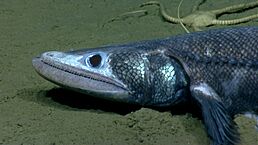Deepsea lizardfish facts for kids
Quick facts for kids Deepsea lizardfish |
|
|---|---|
 |
|
| Conservation status | |
| Scientific classification |
The deepsea lizardfish, also known as Bathysaurus ferox, is a fascinating fish that lives in the deepest parts of the ocean. It belongs to a special family called Bathysauridae. You can find this unique creature in warm and mild seas all over the world. It's important not to mix it up with other "lizardfishes" that live in shallower waters.
Contents
Discovering the Deepsea Lizardfish
The deepsea lizardfish was first described in 1878. A British scientist named Albert Günther gave it its scientific name, Bathysaurus ferox. This name comes from ancient Greek words. "Báthos" means "depth," and "saûros" means "lizard." So, its name means "lizard of the depths."
For a while, scientists thought it was related to other lizardfishes. But in 1996, new research showed it was different. It was then placed in its own family. This helps us understand how different fish species are related.
What Does a Deepsea Lizardfish Look Like?
Deepsea lizardfish look a bit like the lizardfishes found in shallower waters. Adult deepsea lizardfish can grow quite long, over 70 centimeters (about 2.3 feet). They have a long, slender body that looks like a cylinder.
Their head is flat and bony, much like a lizard's head. They have a huge mouth filled with many rows of long, sharp, needle-like teeth. These teeth are perfect for catching and holding onto their prey.
These fish are usually whitish, grey, or brown. Their bodies are covered in tough scales. Some scales along their side are larger and form a special line. This "lateral line" helps them sense movements in the water.
They have large, well-developed eyes with big pupils. Even though sunlight doesn't reach the deep ocean, their eyes are still important. They help the fish spot faint light sources, like bioluminescence (light made by living things).
Deepsea lizardfish also have a very large liver. It can make up to 20% of their total body weight! This big liver acts like a fuel tank. It stores energy to help them grow between meals, which can be far apart in the deep sea.
Where Do Deepsea Lizardfish Live?
Deepsea lizardfish live on the very bottom of the deep ocean. You can find them all over the world, in tropical and temperate areas. They live at amazing depths, from about 600 meters (2,000 feet) down to 3,500 meters (11,500 feet).
This deep part of the ocean is called the aphotic zone. This means "no light zone." The water there is very cold, usually between 3 and 4 degrees Celsius (37-39 degrees Fahrenheit).
Because there isn't much food in the deep sea, not many deepsea lizardfish live close together. For example, in one area, scientists found only 0 to 8 fish in a space as big as 25,000 square meters.
How Do Deepsea Lizardfish Find Food?
Deepsea lizardfish are one of the top predators in the deep ocean. They are not picky eaters and will even eat other deepsea lizardfish! They mostly eat other fish that live near the bottom or in the open water of the deep sea. Sometimes, they also eat crabs, snails, or dead fish that sink down from above.
Most of the time, a deepsea lizardfish stays very still on the ocean floor. It raises its head and front body, waiting patiently for a meal to swim by. When prey comes close, it suddenly lunges forward. Its trap-like jaws snap shut quickly, catching the unsuspecting prey.
Are Deepsea Lizardfish in Danger?
Even though deepsea lizardfish are common in their habitat, scientists are still concerned about their conservation. This means they are watching to make sure these unique fish stay healthy in the ocean.
How Do Deepsea Lizardfish Reproduce?
Deepsea lizardfish are hermaphrodites. This means each fish has both male and female reproductive organs. This is a special adaptation that helps them in the deep sea. Since there aren't many fish in one area, having both organs makes it easier to find a mate and reproduce.
Scientists have found that these fish reproduce at certain times of the year, usually from November to January. This helps them maximize their chances of breeding. On average, each female can produce about 32,000 eggs.
We don't know much about their mating habits. However, young deepsea lizardfish, called larvae, have been found swimming near the ocean's surface. This suggests they might start their lives in shallower waters before moving to the deep.




